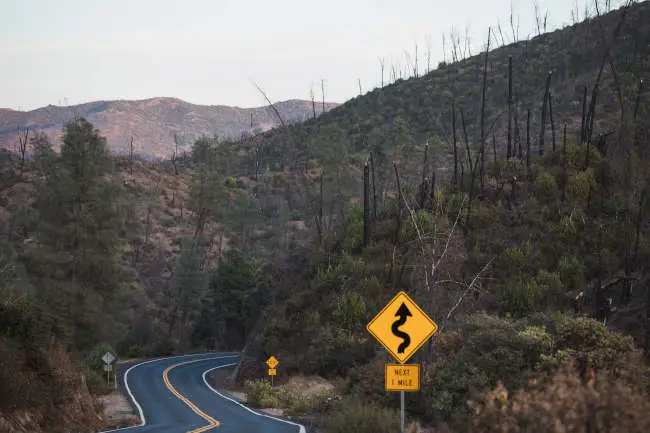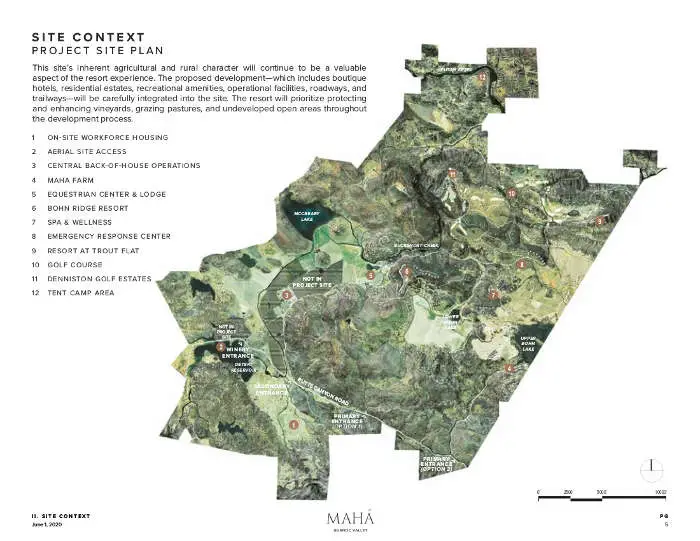
LAKE COUNTY, Calif. — A judge has ruled that the county of Lake failed to adequately consider wildfire evacuation impacts in approving a proposed resort and residential project in Guenoc Valley in 2020.
Lake County Superior Court Judge J. David Markham handed down the 16-page ruling on the Guenoc Valley Mixed Use Planned Development Project — also known as Maha Guenoc Valley — in a filing dated on Tuesday.
Markham has ordered the county’s approval, handed down by the Board of Supervisors in July 2020, to be set aside due to errors in environmental review and violation of the California Environmental Quality Act, or CEQA.
Specifically, Markham found the county failed to consider the project’s impact on the surrounding community’s emergency evacuation routes in the event of wildfire.
At the same time, Markham found the county had adequately mitigated impacts relating to water and species of concern, and that it also had rejected a smaller version of the project based on the necessary evidence.
The Center for Biological Diversity and the California Native Plant Society, with the California Attorney General’s Office intervening in support of them, brought the case against the county in September 2020, two months after the Board of Supervisors approved the project.
By that time, the LNU Lightning Complex had been burning in the area. The case’s plaintiffs pointed to that fire and to the project’s location in a high fire hazard severity zone, where wildfires occurred in 1952, 1953, 1963, 1976, 1980, 1996, 2006, 2014, 2015, 2018 and 2020.
The Attorney General’s Office submitted comment letters regarding inadequacies in the final EIR analysis of wildfire impacts during the environmental review process.
The plaintiffs faulted the county for failing to comply with CEQA not just on the primary matter of wildfire risk but also on other issues such as water, species of concern, roads and greenhouse gas emissions.
“The court recognized that Lake County failed in one of its most important jobs, to consider how a dangerous development in the direct path of fire can increase risks to surrounding communities,” said Peter Broderick, an attorney at the Center for Biological Diversity. “Given the fire threats facing California, I hope decision makers and developers come to see how absolutely crucial it is to consider evacuation challenges when building projects are this risky. No developer should be allowed to make it harder for people to escape catastrophic fires.”
California Attorney General Rob Bonta said Markham’s decision affirms a basic fact: “Local governments and developers have a responsibility to take a hard look at projects that exacerbate wildfire risk and endanger our communities.”
Bonta added, “We can't keep making shortsighted land use decisions that will have impacts decades down the line. We must build responsibly. This is a win for current and future residents of Lake County, who can rest easier knowing that this project will only move forward if the developer takes proactive steps to ensure their safe evacuation if and when a wildfire occurs."
County Counsel Anita Grant told Lake County News that the next steps are the form of judgment and peremptory writ of mandate.
“The judgment will require the county to set aside its certification of the final EIR, the findings relating to impacts as to an emergency evacuation plan, and the approval of the project,” Grant said Thursday evening.
She added, “At this point, I don’t have any information beyond what is in the court’s order.”
Lotusland Investment Holdings Inc. acquired the 16,000-acre Guenoc Ranch property in 2016. Since 2017, the project has been the subject of numerous public meetings and hearings.
Chris Meredith, a partner in the project, indicated in a statement to Lake County News on Thursday that the project isn’t off the table.
“We are reviewing the Lake County Superior Court’s ruling. We remain committed to working alongside the Lake County community and fire safety experts to ensure this project is built in the right way to improve wildfire detection, prevention and response throughout the region,” Meredith said.
The supervisors approved the first phase of the project, which has a combined 1,415-acre footprint dispersed throughout the overall ranch site.
It was not a unanimous vote. Then-Supervisor Rob Brown had opposed approval of the project, raising concerns about an off-site water well.
“This is the largest land use decision this board will ever make,” Brown said at the time.
That first phase, as approved by the supervisors, included 385 residential villas in five subdivisions; five boutique hotels with 127 hotel units and 141 resort residential cottages; 20 campsites; up to 100 workforce housing co-housing units; resort amenities such as an outdoor entertainment area, spa and wellness amenities, sports fields, equestrian areas, a new golf course and practice facility, camping area and commercial and retail facilities; agricultural production and support facilities; essential accessory facilities, including back of house facilities; 50 temporary workforce hotel units; emergency response and fire center; a float plane dock; and helipads.
The promise of economic development and growth from projects like the resort appear to have figured heavily into the county’s financial planning and expectations of future income for transient occupancy, sales and property tax.
In September, as the board was poised to finalize a new round of raises — bringing its total raises approved over the past two years to $21 million — Lake County News asked the County Administrative Office if the county was projecting a continuing growth in revenue to be able to support these raises over the long-term.
“Our Board is fully committed to furthering economic development and growth in Lake County,” the county responded.
District 1 Supervisor Moke Simon, in whose district the project is located, called Markham’s ruling “deeply disappointing.”
“Lotusland had made considerable efforts to mitigate potential environmental concerns, and honor Lake County’s rich tribal history, in their project planning process. Their flexibility and engagement made them in many ways an ideal partner,” Simon said in a statement released to Lake County News.
He said the investments Lotusland proposed, including adding housing supply and even a fire station and helipad, offered the potential for lasting regional economic benefits. “If the ultimate result of this decision is the project not moving forward, that will be a tremendous loss.”
Simon added, “We will continue to welcome any future opportunities to partner with Lotusland and others to promote thoughtful development in Lake County.”

A closer look at the ruling
Markham’s ruling comes two months after the hearing in the case concluded. He said case documents totaled more than 85,000 pages.
During the hearing — which was stretched over two appearances, one in October and the second in November — the county, its attorneys and the counsel for Lotusland had argued that there had been extensive consideration given to the threat of wildland fire and that CEQA doesn’t preclude development.
At the time, Grant said that the board had balanced environmental concerns with the county’s economic vitality — citing the expectation of 300 year-round permanent jobs in its first phase and at its height 750 construction jobs, plus secondary economic development for the region.
Grant also explained that Lotusland had met the county’s requirements and that the project was not rushed through, but had a considerable public comment period.
“Lake County residents know better than many exactly what devastation means when it comes to wildfire. Nobody has to tell the county of Lake about wildfire,” she said during the November appearance.
Markham’s ruling started by noting that the court had to consider two key questions: Was there substantial evidence to support the county’s decision? And did the county proceed in a manner required by law?
In his analysis, Markham looked at the county’s wildfire protection plan, which included components such as vegetation management and firebreaks. That plan was cited as a mitigation in the CEQA analysis, but Markham found that it actually is a part of the project itself.
He wrote that the EIR’s analysis of the project’s impact on wildland fire risk was “extensive and specific to both the Project and its location.
Markham concluded “substantial evidence supports the County’s findings regarding the Project’s impact on wildfire risks” — with one exception, that being the impacts on community evacuation routes.
Taking the point from the Center for Biological Diversity and the California Native Plant Society regarding the fact that “a significant number of wildfire related deaths in California occur during attempts to evacuate,” Markham said wildfire hazards are “certainly exacerbated if community residents are unable to evacuate safely due to congested evacuation routes.”
Markham said the project is estimated to bring 4,070 new residents to the south county, “a significant population increase” when considering that the project is in two Census tracts that as of 2017 had 10,163 residents.
Because a fire would necessitate evacuation, and because that population increase would exacerbate existing environmental hazards, Markham said the issue has to be addressed under CEQA.
He wrote that the county’s conclusion that impacts to existing emergency evacuation plans would be less than significant was based on the opinions of traffic engineers, law enforcement and fire personnel.
“Those opinions were not based on any identifiable facts,” wrote Markham, who explained that since it wasn’t supported by identifiable facts, it was legally insufficient to be considered as “substantial evidence” under CEQA.
“Because the County’s findings regarding community emergency evacuation routes are not supported by substantial evidence, the EIR does not comply with CEQA,” Markham said.
Markham didn’t agree with the petitioners that a carbon credit program added as an errata to the final EIR wasn’t a mitigation measure the county relied on in making any findings in the EIR. To the extent that it didn’t comply with CEQA, Markham found that it didn’t constitute a prejudicial error because it did not deprive the public and decision makers of substantial relevant information regarding the project’s likely adverse impacts.
In the county’s favor was Markham’s finding that the county had used substantial evidence in its findings regarding an off-site well that had concerned Brown and led to his no vote.
Markham ruled the county’s mitigation measure requiring analysis, annual monitoring reports and quarterly reports for the first five years, and a requirement that a groundwater management plan be developed if the reports show impact on groundwater levels, complies with CEQA.
A key argument in the case had been the consideration of a project alternative, alternative C, which the county had concluded would have been infeasible due to reduced economic benefits.
That alternative would have reduced the project’s footprint, increasing the open space and keeping the total number or residential units at the same number but reducing the average lot size from 4.8 acres to 0.8 acres.
Markham said the evidence supported the conclusion that alternative C would have fewer economic benefits for Lake County.
He noted that the Attorney General’s Office said the county should have considered alternative locations for the project that were closer to a transit stop in order to reduce greenhouse emissions.
Markham rejected that suggestion, noting, “The Project consists of high-end residential, resort, and recreational facilities. It is speculative to conclude consumers of the project will travel from out of the area by public transit.”
As such, Markham found the county had properly considered and rejected the project alternatives.
Also complying with CEQA were proposed mitigation measures for special status plants and Markham agreed that the county’s decision not to recirculate the EIR after the addition of an errata complied with environmental law.
As for other issues the petitioners raised, Markham said he was not discussing all of them due to time constraints.
“The court focused on those issues which it considered to be of primary importance in helping the parties to understand the reasons for the Court’s ruling. As to all other issues raised by Petitioners not specifically discussed here, the Court has determined all findings made by the County were supported by substantial evidence and the County otherwise substantially complied with the requirements of CEQA,” Markham wrote.
Markham concluded that the county’s EIR was insufficient due to the wildfire evacuation routes matter and ordered the county to set its final EIR certification aside, along with findings regarding the emergency evacuation plan and the project’s approval.
He ordered the petitioner and intervenor to prepare the judgment and writ of mandate, but did not give a timeline for when that must be completed, and reserved costs and attorneys’ fees.
Email Elizabeth Larson at This email address is being protected from spambots. You need JavaScript enabled to view it.. Follow her on Twitter, @ERLarson, or Lake County News, @LakeCoNews.
Guenoc Valley Ruling by LakeCoNews on Scribd

 How to resolve AdBlock issue?
How to resolve AdBlock issue? 





